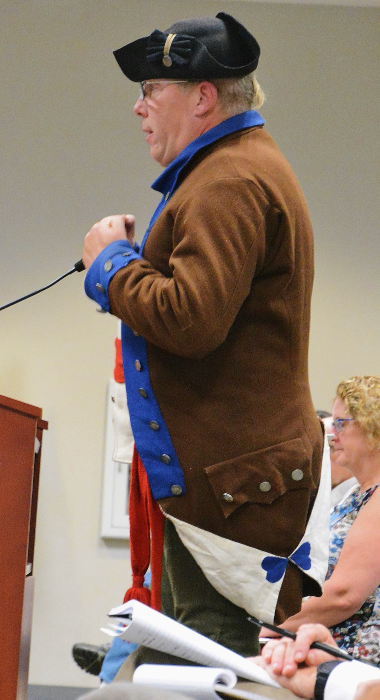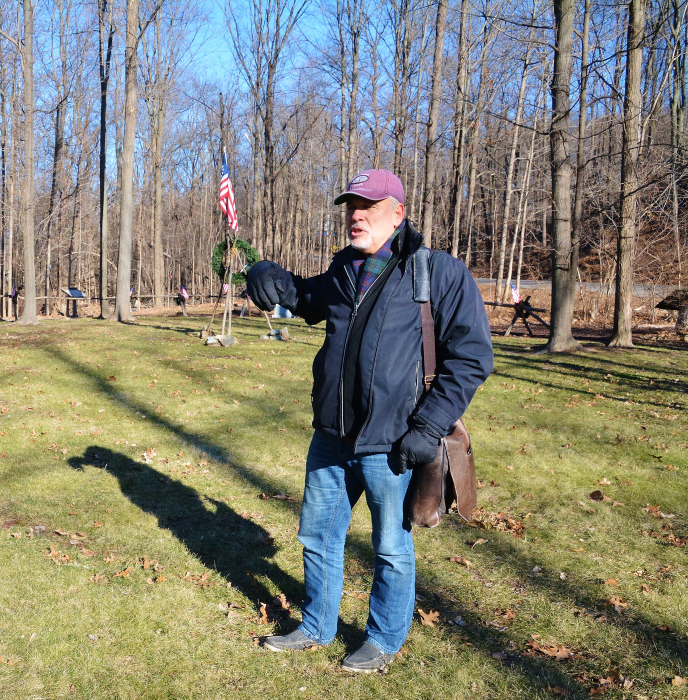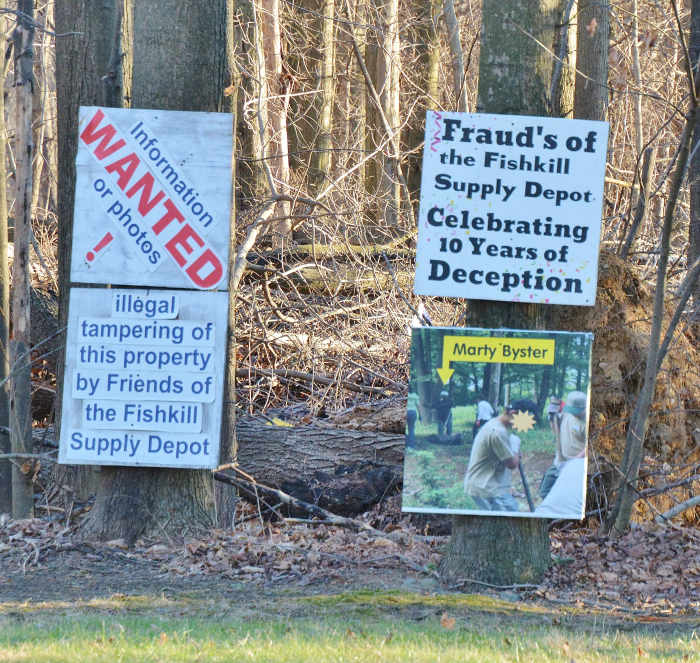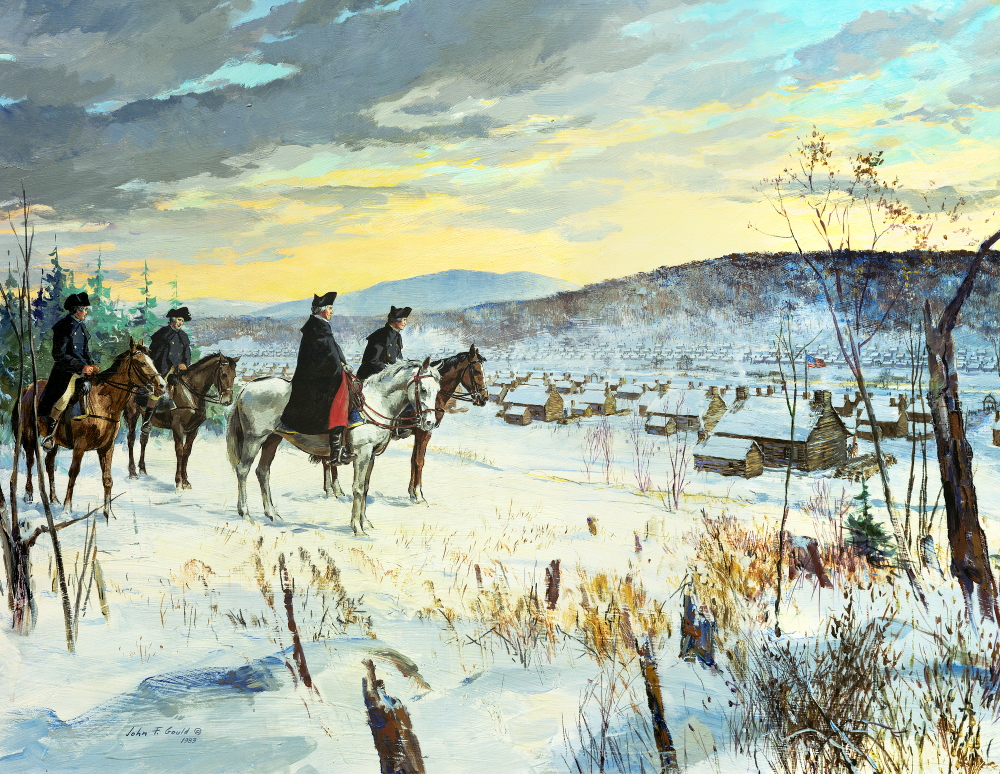Critics oppose themed tourist complex on historic site
What may be the last battle of the American Revolution is being fought in Fishkill.
The fight pits an historical organization and residents against a pugnacious developer. It also involves a local government that until recently seemed ready to accommodate him.
At stake is a 10.5-acre parcel on the east side of Route 9 (the Albany Post Road of colonial days), opposite the largely vacant Dutchess Mall.
Over many years, the dispute has involved a thicket of litigation; allegations that someone salted the property with bones to suggest it contains important patriot burials; political maneuvering; withering attacks on social media; and spying on the historical group by an undercover investigator hired by the developer.
The skirmish reflects broader concerns about the impact of development on neighboring communities, including Beacon, which could end up processing the site’s sewage, and Philipstown, which shares mountains, streams and Revolutionary War history with Fishkill.

Sometimes called Crossroads, the parcel lies across Snook Road from the 18th-century Van Wyck Homestead, a onetime farmhouse now owned by the Fishkill Historical Society that served as a Continental Army headquarters in the epicenter of the Fishkill Supply Depot, which operated from 1776 to 1783.
Established by Gen. George Washington, the entire supply depot sprawled from northern Philipstown to Fishkill Landing (part of present-day Beacon) and Fishkill village (which served as New York’s wartime capital for six months) and extended eastward along the current state Route 52.
During the Revolutionary War, several thousand soldiers and others lived or worked on the site, which included such facilities as barracks, officers’ quarters, blacksmith and craft shops, warehouses, stables, training grounds, an armory, artillery placements, powder magazine, a prison, and other operations essential for the war. Gen. Israel Putnam oversaw the depot, and, like Washington, Alexander Hamilton and John Jay and other colonial leaders came and went.

The depot also sheltered British prisoners of war and its hospitals treated wounded men from battles as far away as New Jersey — a grueling trek in the age of wagon travel — as well as victims of disease.
In 1974, the land around the Van Wyck Homestead, including Crossroads, was listed on the National Register of Historic Places. Crossroads is thought to contain Revolutionary War graves, although that’s a subject of fierce debate.
What is planned
Domenico Broccoli, of GLD3 LLC and Snook-9 Realty Inc., owns Crossroads, which he has valued at $15 million.
Around the gas station, Broccoli wants to construct a complex called Continental Commons, with a 2.5-story, 90-room hotel; 5,000 square feet of restaurant space (perhaps with an International House of Pancakes); 16,000 square feet of retail; and a 720-square-foot visitor’s center, along with parking lots and walkways, all designed to replicate an 18th-century colonial village. In a rendering of the project, military re-enactors interact with visitors, and the buildings are designed to resemble Hudson Valley landmarks, such as the Beekman Arms in Rhinebeck and the Madam Brett homestead in Beacon.

The developer said he will protect any graves, although he maintains that the actual military burial ground lies some miles northeast and that claims to the contrary are a “scam.”
The Friends of the Fishkill Supply Depot (FOFSD), a nonprofit historic preservation organization, has contested the project both in Fishkill Town Board and Planning Board proceedings and in court, and neighbors and other residents have objected on environmental and aesthetic grounds.
In part, opponents question the plan’s compatibility with the town’s 2009 comprehensive plan, which directs town officials to work with state and federal agencies to purchase or preserve the undeveloped portions of the supply depot and “explore how these can best be used to commemorate the activities that occurred on these hallowed grounds, especially those lands where gravesites of former soldiers have been identified.”

They also point to empty retail space and vacant motel rooms along Route 9 and consumers’ passion for internet shopping as negating any need for more malls.
A 2007 dig at the site’s cemetery uncovered eight graves, including one with a skull or skeleton and coffin nails; three more burials were revealed in 2013. Artifacts from the 18th century have turned up, as well.
The FOFSD sees this work as confirming “that hundreds of America’s first veterans, casualties of the War of Independence,” are buried elsewhere on the site in unmarked graves. “There is no known burial site of Revolutionary War soldiers that is larger.” In addition, the group says, the depot “is among the American Revolution’s most important military logistics sites.”
In 2017, citing the possibility that more history remains hidden underground, the FOFSD warned that “commercial development will destroy unique ruins, dishonor the memory of the heroes who served — and are buried — at the site, and permanently scar the historic landscape of Fishkill.”

At a June 2019 Planning Board hearing, Keith Riley, a FOFSD trustee who teaches social studies in the Carmel school district, noted that “in the 1970s, we allowed a valuable piece of history to be paved over. I cannot tolerate this. The Continental Army who fought and died for us deserve better.” (Dutchess Mall opened in 1974 on what had been part of the Supply Depot.)
“You can build an I-HOP anywhere, but there’s only one Fishkill Supply Depot,” said Lance Ashworth, a West Point graduate who is president of the FOFSD.
Johanna Yaun, the Orange County historian and coordinator of the Mid-Hudson activities planned for 2025 to commemorate the 250th anniversary of the start of the Revolutionary War, which will focus on “supplying the army,” recommended the board order an in-depth, sophisticated archaeological study of the Crossroads site. She predicted the board “would look very foolish” otherwise. “Just look across the street at that empty [Dutchess] Mall and ask if that is the legacy you want to leave behind,” she said.
Theresa Kraft, the FOFSD’s secretary, who is also Beacon’s co-historian, said on Dec. 4 that the Crossroads tract’s relevance lies not only in what may lie buried but in what occurred there. “The battle lines have been drawn,” she told town officials. “Please help protect the Fishkill Supply Depot.”
The developer’s view
Broccoli portrays Continental Commons as “a groundbreaking new concept” that “embraces and honors the historic nature of its surroundings and provides visitors a renewed perspective on the meaning of the American Revolution.”
His project website contends that opponents disseminate “made-up facts” and that the parcel’s “archaeological potential has been exhausted” after numerous digs.

The Continental Commons Facebook page refers to the FOFSD as “a radical and extremist anti-development group.” Assorted online postings likewise accuse FOFSD of being “backed by secret donors” (in its most recent tax filing, from 2018, the nonprofit reported receiving $20,000 in donations and spending $15,000, mostly on legal fees) and utilizing “scare tactics and biased evidence.”
The developer argues that FOFSD confuses his property with the 18th-century Rombout cemetery, on Route 52, known to contain graves of Revolutionary War soldiers. “That’s the historic cemetery” involved but “they made people think” old references to one “at the base of the mountain” meant the Crossroads site, he said. Unmarked Revolutionary War graves also could be scattered throughout Fishkill, he added, because “the Fishkill Supply Depot was huge. It wasn’t Domenic’s 10-acre land.”
Broccoli suspects FOFSD members “planted stuff” on his property. In 2012, he said, his team examined the northern end of his site, away from the area of the known burial ground. At a depth of 26 to 31 inches, “we found anomalies that were similar to graves”; he theorizes that unnamed members of FOFSD created these to bolster claims that his property has the “largest cemetery in the country” from the Revolutionary War.

Furthermore, Broccoli said, his land once had billboards that could have left depressions resembling burials. The FOFSD “made people believe that they were graves, that these hundreds of anomalies are hundreds of graves,” he said. “It’s a big scam and I’m not stopping until the truth is told.”
The bones
The Continental Commons website links to a video clip in which a narrator states that FOFSD member Marty Byster “has admitted that he and other members have buried bones on the Continental Commons property.”
On an accompanying audio recording, Byster seems to ask another member: “Were you there when we reburied bones along the foundation that’s exposed?” The narrator speculates that perhaps FOFSD members “want the bones to be discovered, stopping any development, and forcing the value of the land down so they can force the landowner to sell it to them.”
In 2017, GLD3 LLC sued Byster and his purported, unidentified accomplices over the alleged bone-burying, asserting that their actions interfered with Broccoli’s “ability to use the property for development.”

The suit did not accuse Byster or anyone else of criminal conduct; instead, it wanted a judge to bar them from entering the site without permission and to remove the supposedly planted bones.
According to the suit, Ian Bondy, whom Broccoli hired to spy on the FOFSD, recorded Byster’s “bone” comment during a break in a 2015 Planning Board meeting. In a court affidavit, Bondy said that he joined the FOFSD using the name Alec Crosby and even served on its board, recording the group’s activities and compiling some 75 hours of material for Broccoli.
Byster said he remembers mentioning a bone or bones on the occasion Bondy cites but denies wrongdoing. “I didn’t plant anything,” he said in an interview.
What did happen, he said, was that after archaeological digs, he and other FOFSD members received permission, from a man who was then Broccoli’s business partner, to close trenches left partly uncovered. Assisted by Boy Scouts, they completed the work in 2010, in what was was hardly a secret undertaking, Byster said. “I backfilled a trench that contained bones,” he said. “I did nothing but refill a trench.”
Byster said he has spent nearly $30,000 defending himself against the lawsuit, which continues.
Political maneuvers
Local politics have complicated the debate. On Dec. 4, the Fishkill Town Board held a public hearing on approvals for water and sewer hookups for Continental Commons.
The town board scheduled a follow-up hearing and vote on the water and sewer connections for Dec. 18. But when that day arrived, it lacked a quorum, so then-Supervisor Robert LaColla, a Republican who had lost his seat in the November election, moved the proceedings to Dec. 30 — the day before he would leave office and the board would switch from Republican control.

Before the Dec. 30 meeting took place, the incoming supervisor, Ozzy Albra, a Democrat, obtained an injunction from the Dutchess County Supreme Court to stop any action on Continental Commons.
When the newly constituted Fishkill Town Board met on Jan. 8, one of its freshmen members, Louise Daniele, a member of the Independence Party, proposed a moratorium on development, to allow time to review the town’s comprehensive plan and zoning laws.
“This is something that should have already been in the works, but instead we’ve just been building and building,” she said.
Supervisor Albra said that “when you’ve got the lawyers, you’ve got the engineers, and you’ve got the cash, you’ve got the power” in zoning and planning cases. “I’m going to flip that so the citizens have the power…. We’ll protect our water, history and environment.”
The Town Board plans to continue its discussion of a moratorium at its next meeting, on Wednesday, Feb. 5.
Water issues have figured in the environmental concerns about the project. Critics have noted that Continental Commons is over the Fishkill aquifer, which supplies wells and the town with drinking water. But because it plans to connect to a town water district, Continental Commons would not imperil the aquifer and its water and sewer lines would not be funded by taxpayers, according to draft legislation prepared for the Town Board’s aborted Dec. 30 consideration.
Chazen Companies, Broccoli’s consultants, estimate Continental Commons would consume 18,211 gallons of water daily. Its sewage would be channeled into the Beacon treatment system since the Town of Fishkill contracts with Beacon for sewage services.
Broccoli has sued Albra in state Supreme Court over the scuttled Dec. 30 water and sewer connection hearing and Town Board vote. “He went and stopped my approvals,” Broccoli said on Thursday (Jan. 30).
The Friends of the Fishkill Supply Depot also have gone to court. After the Planning Board in April ruled the project would “not have a significant adverse impact on the land,” the FOFSD asked a court to overturn the decision. It accused the Planning Board of favoring the developer and cited a 2015 meeting at which board Chairperson Mary Hendricks said, “I’m not afraid of some ‘hysterical’ society.”

The FOFSD also expressed concerns that Hendricks in 2017 had used her personal email to share information from an archaeological consulting firm that was later hired by the Planning Board, keeping the documents out of the public record.
The group won a preliminary round: In November, a state judge prohibited Broccoli from “disturbing the ground in any way” as the litigation proceeds.
Undeterred, on Dec. 12, the Planning Board reaffirmed its April decision, declaring that Continental Commons “will not result in any significant adverse impact on archaeological or historic resources” or the natural environment.
The project “will undoubtedly result in changes to the aesthetic or scenic quality of the area,” it acknowledged. But farming and development had already altered the site and its “archaeological potential,” it said.
Furthermore, its members found the project to be “consistent with the character of the neighborhood” — Route 9’s commercial sector. If anything is “inconsistent with the neighborhood,” it said, it is the 18th-century Van Wyck farmhouse.
A video created by the developer to promote Continental Commons


I have lived in Fishkill for close to 30 years and I am a neighbor of Marty Byster, who, in my opinion, is one of the most honest, humble human beings I have ever met. His only goal, in all the time I have known him, is to learn and preserve the rich history of our country in this area. He is like a David to the Goliath who wants to bulldoze real history and create faux history to make himself and his company money.
Marty has spent so much of his own money, has been accused, ridiculed and outright lied about by the Goliath(s) whose real interests are financial and by no means preserving the history. God bless men and women like Marty in groups like FOFSD who are not anti-growth but pro our country and pro-history.
Recognized, potential and unidentified archeological resources for which the Fishkill Supply Depot site was listed on the National Register of Historic Places in 1974 within the Continental Commons development site, itself entirely within the Depot Site, are at risk to the adverse effects of that development. Precautions to protect these resources as required under New York SEQRA have not been committed by the developer.
The three recognized resources are identified as a “barn,” a “brick” works, and as Feature 1, together with three other features potentially the corners of one or more structures within a footprint measuring 45 feet by 30 feet (approximately the outside dimensions of the west wing of the Fishkill Historical Society).
Five features are identified among eight square areas, measuring 50×50 feet, using ground penetrating radar as potential man-made structures with associated artifacts.
There is no commitment for a comprehensive examination of the entire development site using ground-penetrating radar to assure all remaining structural and associated artifacts which remain within the site are identified contrary to the most recent discoveries, including a burial site with human remains and potential manmade structures and the conclusions in earlier archeological reports that significant resources will lie below grade.
The recognized and potential resources are summarily dismissed on speculation, without close examination at depth.
A Phase III archeological examination of the site proposed to a previous owner for preventing the adverse effect of development on the remaining archeological resources and clear the site for development under SEQRA was ignored by the Town of Fishkill Planning Board.
“Were you there when we reburied bones along the foundation that’s exposed?”
Individuals may verify for themselves that the word “along” represents the author’s interpretation of what on the tape is to me indecipherable and I believe to be the word “and.”
In our original post, we identified Fishkill town board member Louise Daniele as Democrat. Although she received the most votes on the Democratic line of the November ballot (2,318 votes versus 200 for Independence and 187 for Working Families), she is a registered as a member of the Independence Party. The story has been corrected to reflect this.